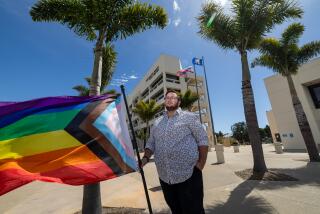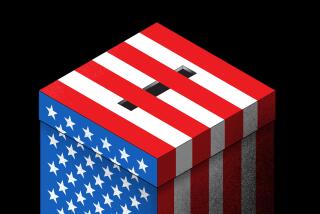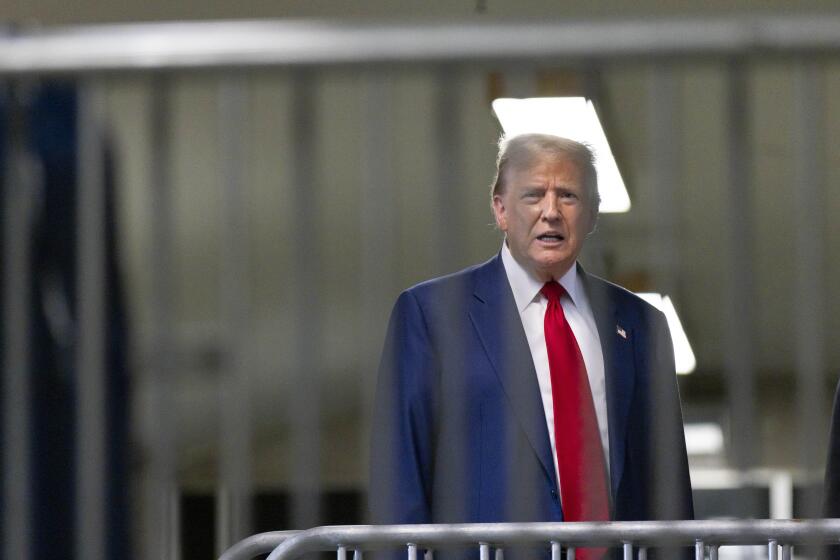Davis Finds ‘No Good Choices’ in Slicing Budget
The mood was grim as Gov. Gray Davis and senior advisors gathered in his Cabinet room in mid-December. For weeks, they had struggled to come up with billions of dollars in spending cuts to close an enormous state budget shortfall.
Now, with a deadline at hand to print his budget, Davis peered through his reading glasses, staring at a list of cuts he already had rejected at least once. He pointed to an item that would eliminate 10 benefits now paid for by Medi-Cal, the state health program for the poor, including artificial limbs and braces used by 120,000 Californians.
“Let’s do these,” he said, grimacing as he spoke, a witness recalled.
Nearly five months later, the decisions that Davis and his aides agonized over in December are driving a tortuous debate in the Legislature over how to fix California’s fiscal mess. Amid the bickering, Republican and Democratic lawmakers last week found enough common ground to agree on a $3.6-billion package of cuts and borrowing.
But they still have made only modest progress in addressing a shortfall estimated at $35 billion over the next 14 months. Like Davis, they have delayed agonizing choices, and in the weeks ahead will have to weigh cutting health care for the poor against reductions in education or transportation or some other slice of the state budget.
Davis’ budget, which includes $20 billion in cuts and savings this year and next, is the sum total of hundreds of small choices -- things so seemingly coldhearted as denying prosthetics to amputees, a benefit that would save the state only $2 million next year in a budget of nearly $100 billion.
How the governor made those decisions illustrates the struggle to balance policy and politics as the gap between state spending and tax collections has hit record levels. The decisions were thrashed out in mind-numbing meetings that often lasted late into the night.
Davis captured the mood with a line that became a mantra for the sessions: “There are no good choices here,” aides recalled him saying over and over as they attempted to balance the budget by partially dismantling programs they had championed for the last four years.
Tempers flared. Debates raged in which talk of dollars withheld would translate into discussions of sickness and death versus inconvenience and indignity. At one point when someone suggested rolling back health insurance for the children of the working poor, participants said, Davis banged a hand on the table and shouted: “We have to stand for something here!”
This account of the sessions that led to Davis’ proposed health care cuts is based on separate interviews with the governor, four participants in the discussions and two people who observed parts of the deliberations.
Last fall, as Davis sought to fill the deepening budget hole, Medi-Cal was a logical place to look. The joint federal-state program, California’s version of Medicaid, will serve about 6.5 million people and cost about $27 billion this year. That’s nearly one-quarter of the annual state budget. But the Democratic governor said he proposed cuts in the health safety net for California’s neediest citizens with great reluctance.
“I don’t want to take prosthetics away from anyone,” Davis said in an interview. “I don’t want to deny injured or sick people the benefits they currently enjoy. It’s an extraordinarily painful process. Nobody goes into government to do this. If somebody can show me how we can get out of this thicket without causing pain to individuals, I’ll embrace it in a New York minute.”
Critics accuse Davis of lacking convictions and a moral compass, but senior advisors say his internal discussions on the budget cuts offer evidence to the contrary.
“We had to ask: What’s the difference between life and death?” said Susan Kennedy, the governor’s Cabinet secretary and chief budget strategist during last year’s deliberations. “Are we going to take syringes away from [diabetics] or throw these people off health insurance altogether? If you had to choose between dialysis and incontinence supplies, which would you eliminate?”
*
Year-Round Struggle
Shaping the state budget has become a year-round struggle in Sacramento in recent years. The governor submits a budget to the Legislature by Jan. 10 and revises that plan in May to reflect changes in tax collections and demands on state services.
Lawmakers are supposed to submit their version of the budget for the governor’s signature by midnight June 15, and the governor is supposed to sign it by June 30, the end of the state fiscal year.
Last year, the Assembly couldn’t muster the votes needed to pass the budget until Sept. 1. By that time, the Davis administration was already at work on the 2003-04 budget.
In a normal year, state agencies submit wish lists during the summer for how an agency or department hopes to increase spending. Last summer, however, the Finance Department asked every office to show how it would cut up to 20% of its budget.
In mid-September, five specialized budget units began considering the possible cuts: everything from not buying a photocopier to reducing the hours of a receptionist or leaving a position vacant. The budget experts began drafting their own list, dividing the cuts into three categories ranked by political or legal difficulty.
Privately, Davis made two preferences clear to his staff: Concentrate on spending cuts rather than tax increases, and, as a first option, scale programs back to the level that he inherited in 1999 from Republican Gov. Pete Wilson, aides said.
“No half-measures,” Davis instructed, according to aides. “I don’t want to have to deal with this problem every year for the next three years.”
By October, Kennedy and her deputy, Nancy McFadden, had started to shape the rough outlines of the governor’s budget in meetings with Finance Director Tim Gage, his deputy Betty Yee, other key finance aides and a pair of former lawmakers, Phil Isenberg and Pat Johnston.
Gage and Yee had been at the Capitol during the state’s last budget crisis in the early 1990s. Isenberg and Johnston, participants in the debates over the Wilson-era cuts, were brought in to look for political pitfalls. *
Possibilities Listed
A list of possible cuts began to take shape, “department by department, program by program,” Gage said. Behind closed doors, Kennedy was advocating a “scorched-earth policy,” which she defined as cutting something from almost every program, no matter how small. That made fiscal sense, given the size of the shortfall they were facing. But Davis aides also calculated that it would be easier to defend the cuts in health care and social services if they could point to reductions in other areas.
“How could you have a fully funded Arts Council when you were cutting prosthetics and dental benefits for people?” one senior advisor asked.
After winning reelection Nov. 6, Davis turned his full attention to the budget shortfall. Eight days later, the nonpartisan legislative analyst projected the size of the problem at $21 billion in the 19 months ahead.
The budget discussions soon turned to Medi-Cal. Under federal Medi-Cal rules, states must provide a number of basic health services. Additionally, there are 34 “optional” benefits they can provide, such as adult dental care, dialysis treatment, prescription drugs, and medical equipment such as wheelchairs and prosthetics.
Davis was familiar with many of the benefits and their recipients from his budget deliberations earlier in the year. In fact, he had proposed cutting adult dental care and several other optional benefits in last year’s May budget revision, but the Legislature’s Democratic majority rejected the idea.
*
Looking at Medi-Cal
When it began looking again at cutting Medi-Cal, the Davis team divided the optional benefits into two groups: those that were essential for life, such as dialysis; and those that contributed to quality of life, such as hospice care, orthotics and prosthetics.
In long sessions in the governor’s Cabinet room, just outside his private office, Davis and his senior aides considered what to cut.
Davis sat at his customary place at the head of the room’s long, cherry-veneer table, crafted for his predecessor by inmates at Mule Creek State Prison. Seated around him were his closest advisors: Kennedy, McFadden, Gage, Yee, Isenberg and Johnston, sometimes joined by Chief of Staff Lynn Schenk. Department and agency heads were excluded to prevent news leaks, which could prompt intense lobbying against decisions even before they were announced.
Davis would listen as his aides explained the impact and projected savings of a proposed cut, then fire off questions that he says helped him understand the impact of his decisions “in the real world.”
“He would say, ‘Don’t just give me numbers and bureaucratic gobbledygook. Who are these people?’ ” Kennedy recalled. “He asks their age, their income level. Are they in nursing homes? Are they disabled? He asks these really personal questions, which makes it harder [to make the cut]. It’s a very painful process.”
At one point, after long discussions, senior aides persuaded Davis to cut adult diapers used by prostate cancer patients.
Davis “woke up the next morning and said, ‘I can’t live with this,’ ” Kennedy said. “He was just screaming at us, ‘Incontinence supplies! You’re talking about people who have had prostate cancer!’ ”
Davis says it’s not unusual for him to sleep on a decision and change his mind the next day. In the case of cutting adult diapers, “I found that just totally unacceptable,” he said. “It speaks to the dignity of every human being.”
The sessions had a pattern: Kennedy would make the case for a particular cut and McFadden would weigh in with reinforcement. Gage would give the numbers, then Yee would boil down the financial considerations to the bottom line.
Sometimes they worked late into the evening, interrupted only by takeout dinners from the Esquire Grill. A fastidious eater, Davis ordered the same meal of grilled salmon and steamed broccoli night after night. His advisors were more inclined to snack on bowls of trail mix and bottled water.
On the evening of Dec. 4, Davis finished a round of about $9 billion in program cuts and savings, including eliminating adult dental care, medical supplies and six other Medi-Cal optional benefits. Adult diapers were spared. So were 10 optional Medi-Cal benefits he considered cutting but didn’t, including prosthetics.
In part, Davis and his aides feared that the Legislature’s Democratic majority would reject any package that cut Medi-Cal too deeply, advisors said.
*
A Dispiriting Week
Davis announced his midyear cuts Dec. 6, then plunged back into a final, dispiriting week of deliberations over the upcoming 2003-04 budget. Already, the administration was feeling the pressure from Democratic lawmakers and advocacy groups.
Adding to their frustrations, each time Davis and his aides thought they were finished cutting, the projected shortfall seemed to rise. From $21 billion when they started several weeks earlier, the projected hole had risen to nearly $35 billion.
When budget experts presented Davis with the final shortfall projection in early December, “he just laughed,” one participant recalled. “He couldn’t believe it.”
By now, the list of possible solutions had narrowed dramatically. Davis refused to consider more than $8.3 billion in tax hikes for 2003-04 and limited public education cuts to about $5 billion or less, removing the largest single chunk of state spending from further discussion. He also rejected the early release of prisoners as a cost-cutting move in the Department of Corrections budget. “I’m not going there,” aides recalled him saying.
Around Dec. 13, with only five days to go before the budget went to the printer, Davis still faced an $11-billion hole. He returned to the proposed cutbacks he had passed over earlier.
Among them was the package of 10 Medi-Cal benefits, including wheelchairs and other medical equipment, hearing aids, prosthetics and physical therapy. Cutting them would save $175.6 million in 2003-04, administration officials projected.
As Davis pored over the list one final time, there was little discussion in the Cabinet room. “There’s this look he gives us, like ‘I don’t want to do it but I’ve got to do it,’ ” one advisor recalled. “He was very quiet, somber.”
In the months since Davis unveiled his budget, the plan has been widely denounced by Democratic lawmakers who criticize the spending cuts as heartless, and by Republicans who loathe the tax increases. But Democratic lawmakers have yet to present an alternative budget, and Republican proposals -- which call for the state to borrow money to cover part of the shortfall -- raise unresolved legal and constitutional issues, analysts say.
For now, lawmakers have rejected eliminating payments for prosthetics and their Medi-Cal benefits. Davis won’t say whether he will take any of those proposed cuts off the table when he presents his revised budget May 14. But if he does, the state’s shaky finances will force him to propose another cut for each one he rescinds.
“You could find a whole range of cuts in any part of the budget and find fault with them, and I would agree with you,” Davis said. “But when you look at the totality of what we had to do, you understood somewhere, someplace, something had to give, and there were no good choices.”
More to Read
Get the L.A. Times Politics newsletter
Deeply reported insights into legislation, politics and policy from Sacramento, Washington and beyond. In your inbox three times per week.
You may occasionally receive promotional content from the Los Angeles Times.






